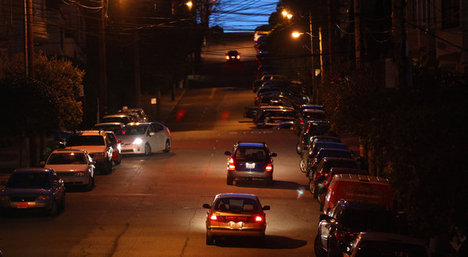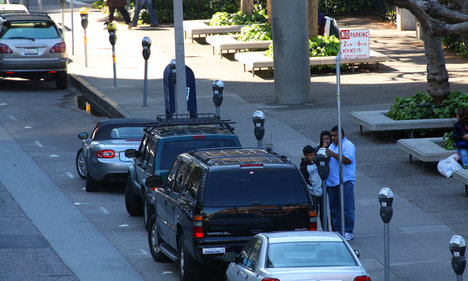 “San Francisco is a city chronically plagued with a shortage of street parking. On a recent night in the North Beach neighborhood, the slow chase for a parking space was well under way.” Source of caption and photo: online version of the NYT article quoted and cited below.
“San Francisco is a city chronically plagued with a shortage of street parking. On a recent night in the North Beach neighborhood, the slow chase for a parking space was well under way.” Source of caption and photo: online version of the NYT article quoted and cited below.
(p. A1) SAN FRANCISCO — The maddening quest for street parking is not just a tribulation for drivers, but a trial for cities. As much as a third of the traffic in some areas has been attributed to drivers circling as they hunt for spaces. The wearying tradition takes a toll in lost time, polluted air and, when drivers despair, double-parked cars that clog traffic even more.
But San Francisco is trying to shorten the hunt with an ambitious experiment that aims to make sure that there is always at least one empty parking spot available on every block that has meters. The program, which uses new technology and the law of supply and demand, raises the price of parking on the city’s most crowded blocks and lowers it on its emptiest blocks. While the new prices are still being phased in — the most expensive spots have risen to $4.50 an hour, but could reach $6 — preliminary data suggests that the change may be having a positive effect in some areas.
For the full commentary, see:
MICHAEL COOPER and JO CRAVEN McGINTY. “A Meter So Expensive, It Creates Parking Spots.” The New York Times (Fri., March 16, 2012): A1 & A3.
(Note: ellipsis added.)
(Note: the online version of the commentary has the date March 15, 2012.)
 “San Francisco has installed sensors and new meters on some blocks to track where cars are parked and set prices accordingly.” Source of caption and photo: online version of the NYT article quoted and cited above.
“San Francisco has installed sensors and new meters on some blocks to track where cars are parked and set prices accordingly.” Source of caption and photo: online version of the NYT article quoted and cited above.
